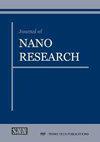应变和热梯度控制纳米管上的质量输运:分子动力学研究
IF 1
4区 材料科学
Q4 MATERIALS SCIENCE, MULTIDISCIPLINARY
引用次数: 1
摘要
根据运动方式的不同,纳米电机可分为线性纳米电机和旋转纳米电机。纳米电机作为纳米机器的核心部件,具有广阔的研究前景和应用前景。本文采用分子动力学方法模拟了碳纳米管衬底上的线性纳米电机。结果表明,温度梯度、衬底轴向应变和纳米电机尺寸对纳米电机速度有很好的控制作用。当纳米马达在两端温差为200 K的衬底碳纳米管上稳定移动时,在15%应变条件下,纳米马达在衬底碳纳米管上移动相同距离所需的时间比在无应变条件下长62%左右。纳米马达的运动和速度控制机制是由作用在纳米马达上的热泳力决定的。其中,热泳力随衬底温度梯度的增大而增大,随衬底应变的增大而减小。这些结果为纳米电机的速度控制提供了一种新的方法,为纳米电机的设计和制造提供了依据,并对纳米电机的机理和运动规律有了更深入的了解。本文章由计算机程序翻译,如有差异,请以英文原文为准。
Controlled Mass Transportation on Nanotubes by Strain and Thermal Gradient: A Molecular Dynamics Study
According to the motion style, a nanomotor can be classified into linear nanomotor and rotary nanomotor. Nanomotors, as the core components of nanomachine, have broad research prospects and applications. Here, a molecular dynamics method is used to simulate the linear nanomotor on a stretched carbon nanotube substrate. The results show that the nanomotor speed is well controlled by the temperature gradient, the axial strain of the substrate and the nanomotor size. When the nanomotor moves stably on the substrate carbon nanotube with a temperature difference of 200 K at both ends, the time required for the nanomotor to travel the same distance on the substrate carbon nanotube with 15% strain is about 62% longer than that without strain. The mechanism for the nanomotor movement and speed control is attributed to the thermophoretic force acting on the nanomotor. Specifically, the thermophoretic force increases with increasing substrate temperature gradient and decreases with increasing substrate strain. These results provide a novel method for controlling the speed of a nanomotor and inform nanomotor design and manufacture, as well as presenting a deeper understanding of the mechanism and movement law of the nanomotor.
求助全文
通过发布文献求助,成功后即可免费获取论文全文。
去求助
来源期刊

Journal of Nano Research
工程技术-材料科学:综合
CiteScore
2.40
自引率
5.90%
发文量
55
审稿时长
4 months
期刊介绍:
"Journal of Nano Research" (JNanoR) is a multidisciplinary journal, which publishes high quality scientific and engineering papers on all aspects of research in the area of nanoscience and nanotechnologies and wide practical application of achieved results.
"Journal of Nano Research" is one of the largest periodicals in the field of nanoscience and nanotechnologies. All papers are peer-reviewed and edited.
Authors retain the right to publish an extended and significantly updated version in another periodical.
 求助内容:
求助内容: 应助结果提醒方式:
应助结果提醒方式:


